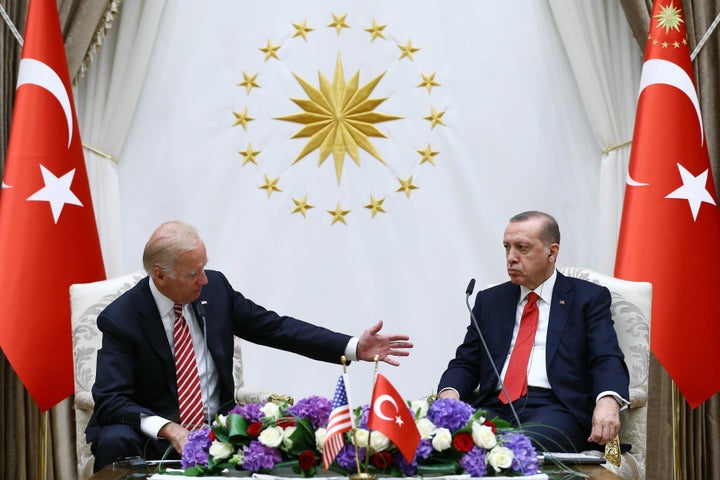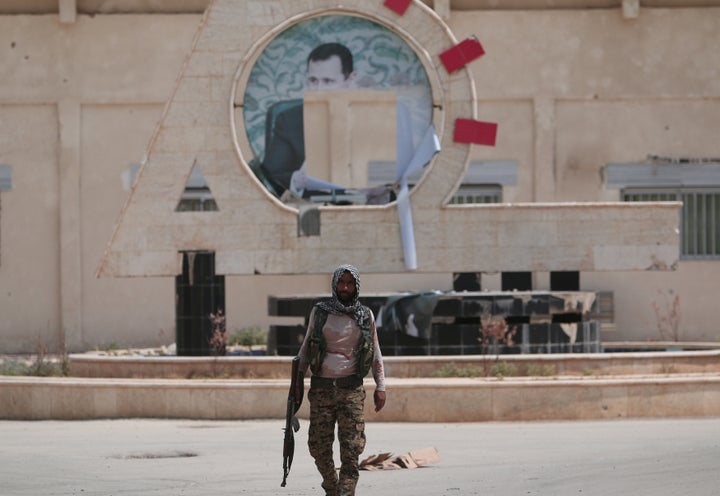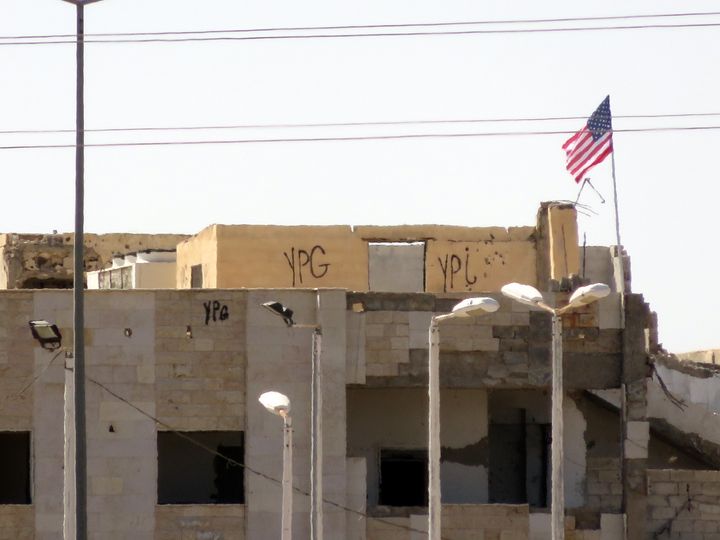WASHINGTON ― U.S. forces operating in northern Syria raised American flags in the region last week, a Defense Department spokesman told The Huffington Post on Monday.
The revelation comes after theories about the flags have been circulating on social media for days, as observers of politics in the tense region ― where Kurds, Arabs and Turks all connected to the U.S. are competing for power ― guessed at the provenance of the stars and stripes.
One school of thought suggested that Syrian Kurdish forces, which are key U.S. partners in the fight against Islamic State militants but terrorists in the eyes of U.S. ally Turkey, raised the flags to fake a U.S. presence in their territory. Another said that U.S. special forces raised them while visiting Kurd-controlled territory to avoid becoming collateral damage in one of the occasional Turkish attacks on the Syrian Kurds.
The new Pentagon statement puts one of those theories to bed. Asked specifically about the American flags spotted flying over the town of Tal Abyad, U.S. Army Maj. Josh Jacques, a U.S. Central Command spokesman, said, “I can confirm last week that U.S. forces operating in northern Syria used flags to denote their positions.”
And the U.S. is not permitting any other groups ― including the Syrian Kurds ― to fly the U.S. flag, according to Col. John Dorian, a spokesman for the campaign against the self-described Islamic State.
The need for damage control over the seemingly minor incident is a reminder that as the Obama administration tries to secure a nationwide ceasefire so that the various actors involved in Syria can focus on ISIS, it may ignore concerns that actually drive those players ― and could lead to continued conflict for years to come.
While Turkey and the Syrian Kurds are both battling ISIS, the Turks say the Kurdish forces are just as dangerous as the radical Islamists because of their links to a violent Kurdish insurgency inside Turkey. Turkey encourages Syrian Arab groups to take a similar line, despite the fact that many Arabs and Kurds share the larger goal of unseating Syrian dictator Bashar Assad. On Monday, Turkey’s ambassador to the United Nations, Mehmet Ferden Carikci, called on the organization to investigate the Syrian Kurdish fighters for alleged human rights abuses.
Media close to the Turkish government made it immediately clear that Ankara was unhappy about the sighting of the flags in Kurd-controlled territory. Turkish sources presented the event as an example of Kurdish overreach ― a way to exaggerate the Syrian Kurds’ ties with Washington, and a deliberate deception.
 Anadolu Agency via Getty Images
Anadolu Agency via Getty ImagesThat portrayal has turned out to be inaccurate. Instead, sources close to the Kurdish militia, the YPG, appear vindicated. Before the Pentagon shared its statement, one activist with close ties to the Syrian Kurdish leadership told HuffPost that U.S. forces were present in the town and raised the flags to prevent potential bombardment by Turkey, echoing a narrative popular in pro-YPG social media.
Kurdistan24, an outlet based in Iraqi Kurdistan, used a Kurdish name to refer to the town where the flag was spotted and published multiple stories suggesting that U.S. forces there were worried about Turkey’s behavior. In one story, a YPG official was quoted saying the Americans wanted to monitor their treaty ally ― a striking claim given that the Americans and Turks are partners in NATO and have a history of military cooperation. In another, the outlet quoted unnamed U.S. officials who had suggested to CNN and Hurriyet, a Turkish paper, that American forces suffered firing from Turkey. Both Pentagon spokesmen that HuffPost contacted declined to comment on that claim this week.
The U.S. has struggled to satisfy both its partners. While it agrees with Ankara on calling the Kurdish movement in Turkey, the PKK, a terrorist organization, it describes the chief Kurdish militia in Syria, the YPG, as distinct from that group.
“It’s a complicated and crowded battlefield,” Dorian said. “We understand that in order to be successful we’ll have to manage all these operations. Sometimes partners have interests that aren’t aligned.”
The flag drama carries echoes of an earlier controversy connected to the U.S.’s blossoming relationship with the Syrian Kurds. In May, photographs published in major media outlets showed American special forces in northern Syria wearing uniforms bearing the YPG insignia. Turkey lambasted the U.S. government, calling it “two-faced.”
The flag incident is even more complex because it suggests an American acceptance of the status quo in the town where the sighting took place. Kurdish forces have controlled Tal Abyad since June 2015. Though they liberated the town from ISIS, their rule there has been controversial because of its effect on thousands of local Arabs. Syrians who fled the region because of fighting between ISIS and the YPG told HuffPost they were wary of ethnic discrimination from the Kurds, and a VICE News investigation months later found that many chose to remain in Turkish refugee camps. Amnesty International has accused the YPG of forcibly displacing Arabs in regions they have captured during the Syrian civil war and said that amounts to war crimes.
Alienating Arabs, the majority ethnic community in Syria, would make getting anything done there more difficult for the U.S. Still, Syrian Arab forces skeptical of the YPG have long complained that Washington is ignoring their grievances. The Arab groups, many of whom have ties to Turkey, say they do not trust the Kurdish militia because of its behavior toward Arabs and because it has had a cold truce with Syrian dictator Bashar Assad’s regime in some areas.
The YPG say they have clearly indicated they want Assad’s rule to end, in large part because of his continuing crimes against Syrian Kurds, and that they are willing to work with Arabs as long as they disavow fundamentalist thinking rooted in Islam. They note that thousands of Syrian Arabs live in the Kurd-run region of Syria, Rojava, and are involved its politics and its defense.
 Rodi Said / Reuters
Rodi Said / ReutersThe U.S. tried to soothe these tensions last year by encouraging the YPG to join with some Arab forces in a new organization called the Syrian Democratic Forces, but many dismiss the alliance as a front for Kurdish ambitions. Last week, video emerged that appeared to show Syrian rebels in the northern Syrian town of Al-Rai threatening to “slaughter” U.S. special forces as they pulled out of the town in heavily armed vehicles. The rebels had slammed the Americans for supporting the YPG, according to Charles Lister, a senior fellow at the Middle East Institute.
Despite these tangles, the U.S. is only getting more involved in the region and trying to maintain ties on all sides. American officials announced last week that some 40 U.S. special forces would be tasked to work alongside Turkish forces on the ground in Syria, to aid an operation Turkey has launched to create a zone that is controlled by neither ISIS nor the YPG.
Announced less than a month after the latest direct clash between Turkey and the Syrian Kurds, this plan means that there will soon be U.S. forces on both sides of this cold peace. (Hundreds of U.S. special forces are already embedded in Kurd-controlled territory.)
The U.S. had negotiated a quasi-truce between the two forces that held for months, with the understanding being that the Turks would leave the Kurds alone as long as they remained on the eastern side of the Euphrates river and did not expand their presence into largely Arab areas west of the river.
But the Kurds argue that they need to have access to that western side to be able to reach a small Kurdish enclave in northwestern Syria that is otherwise surrounded by unfriendly forces. They have made incursions into the region since January of this year, angering Turkey because it says it cannot tolerate a Kurdish corridor all along the Turkey-Syria border that could eventually be used for attacks on the Turkish state. These worries are a prime reason for the current U.S.-backed Turkish operation in Syria.
Dorian, the anti-ISIS campaign spokesman, acknowledged that there’s a quandary the U.S. has yet to resolve. But he couldn’t offer a solution just yet.
“When we have to be flexible because something doesn’t go as planned, we’ll have to figure out how to get everyone refocused on the unifying principle: nobody wants Daesh in Syria and Iraq except Daesh.”




